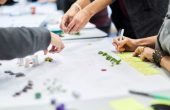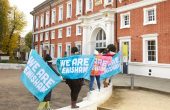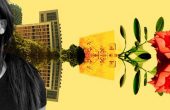Whitney McVeigh is a Fellow in Creative Practice at London College of Fashion. As a practicing artist in painting, installation and film, Whitney is working under an interdisciplinary area of research entitled Human Fabric. Human Fabric looks at our collective history, linking our common threads through land, our clothes, our borders, our everyday belongings and our philosophies. It’s about who we are, where we come from and celebrating our universality as humans. Her latest piece of work ‘1000 Coats’ caught my eye, as a project that uses fashion (sewing) to strengthen community ties, provide learning and improve well-being – something I am also very passionate about. Through the project 100 women will sew 10 coats each, learning sewing skills and making connections with other women along the way. The finished coats will then be given to a chosen charity for children. I decided to get in touch and ask her a few questions about the inspiration behind her work.
What role can art play in community life? Why do you think it’s important?
About three years ago, I began to see the importance of working in communities coming out of the more solitary nature of the studio. Conversations took place with artists and writers showing the benefits of collaborative work to bring about change and impact ordinary lives. There is growing evidence, particularly in a technologically evolving world, that the importance of community and community based work holds value. Working together creates stronger ties and more stable lives. For example, my film ‘Birth: Origins at the end of life’ enabled the women to talk about their memories of birth, not something often spoken about publicly. In doing so it helped to acknowledge a deeper sense of self.
What made you decide to choose sewing, as a medium for your project ‘1000 Coats’, and why coats specifically?
Sewing is a process, another form of making and cathartic in ways just as drawing can be. My research Human Fabric will be embroidered into the coats drawing attention to the threads that connect us as humans. Shelter is not often something that’s provided through the arts and is an essential necessity to all human life. By creating the coats for children, one is making a genuine impact on other people’s lives. A coat is symbolic, a metaphor for shelter and protection.
You make the point of gifting the finished coats to charity for children. Why do you think this is important?
Sometimes in order to live more fully we need to give back. As my children grow up I see the world differently and there’s a fundamental need to make a contribution. By giving the coats away it makes a comment on art traditionally gifted into society. Lewis Hyde’s The Gift talks about this as an ‘act of social faith’ – art not remaining stagnant in a museum or institution. The emphasis is on a work that is made by society for society. It’s also about the merging of generations.
You are interested in the “universality of humans”. What do you think clothes can reveal about this?
I’m interested in finding common threads through everyday life and in the notion of a border – enabling us to see that we have more shared than we sometimes believe. There are infinite cross overs through religions and culture – if we embrace these more there is potential for universal and shared beliefs and the possibility of dissolving differences. Clothes are made of parts and sewn and have seams. How can we represent our shared culture through the body. Increasingly in the work I’m looking at ordinary life and I see my paintings representing the body as landscape, holding territories within. Perhaps there can be an integration of philosophy and clothing that celebrates the act of making by the hand itself. By using fabrics with an existing history for the coats, the work becomes about regenerative memory.
Do you think art has a responsibility to have an impact on people’s lives?
Art provides a means of accessing truth and beyond. It cultivates, strengthens and opens up lives through the making of and telling of stories. The artist can travel deep into the material, this is the task, to uncover spaces previously unknown and to reveal something perhaps indiscernible in life. To bring new light, new meaning and a kind of collective awareness. I travel to broaden knowledge and seek meaning and experience in the lives of ordinary people. A recent trip to Ethiopia showed me that making is valued and integrated into daily life forming traditions and rituals that uphold culture. So yes, in this sense I think it does. I feel increasingly that art has a responsibility to contribute to society because of its often-negative commercial status, varied nature and infinite scope.
Be sure to check out more of Whitney’s work here and her latest show ‘Contours’ opened at The HAZARD Gallery in South Africa last Thursday.




